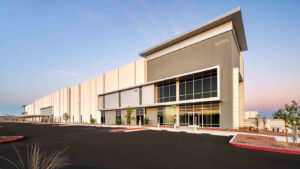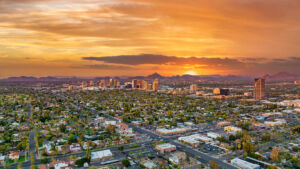As the Phoenix market grows, so does the demand for goods and places to sort, store and ship them. At the same time, the cost of doing business in coastal markets is becoming unmanageable for some companies, so Phoenix is a very attractive (and much more affordable) alternative. This double whammy has turned Phoenix into an emerging hub for new warehouse facilities and fulfillment and distribution centers.
“There are several factors positioning Phoenix as a distribution/warehouse leader in the region,” said Mike Sacco, vice president of the Western Regional Office for EastGroup Properties, a major industrial developer in the U.S. “Major factors include its geographic location in relation to other major markets, an overall favorable business environment, the lack of natural disasters, reliable and relatively cheap energy and the climate, which virtually eliminates weather related transportation delays.”
About 35 million consumers in the Western United States are within a day’s truck haul from warehouses in Phoenix, one of the hottest industrial markets in the country right now as developers rush in to meet e-commerce and third-party logistics demand. Phoenix is well-positioned not just because of its location, but also because it has a robust freeway system. New freeways like the Loop 303 and the South Mountain Freeway have opened up new areas of development that will put more square footage within close proximity to major freeways.
According to the Colliers International Q4 2018 Industrial Market Report, developers delivered 7.8 million square feet of new industrial space to the Phoenix market in 2018. Of that space, 5.4 million (or 70 percent) was warehouse space and 1.6 million was distribution space.
The figures for 2019 are trending in a very similar fashion, according to Cushman & Wakefield’s 2019 Q2 Industrial Market Report. As of the end of Q2, there was 7.6 million square feet of industrial product under construction in the Greater Phoenix market and 4.1 million square feet of that is distribution related space. The majority of this new distribution space is centered in the Southwest submarket, with 2.6 million square feet in the pipeline. Glendale has 1.5 million square feet under construction and the Gilbert/Gateway Airport submarket and the Chandler submarket combine for 2 million square feet.
This new burst of distribution space is not like the old school warehouses. Past warehouses were tiny compared to the modern industrial buildings, and the new generation of distribution center is more efficient, both in functionality and in cost to operate.
“The old buildings had low clear height, tight coverage ratios, little car parking, little to no trailer parking, old metal halide lighting, maybe evaporative cooling, if any cooling, and were located in more infill areas like Sky Harbor Airport, Grand Avenue, Tempe/Chandler/Mesa,” said Will Strong, executive managing director for Cushman & Wakefield, whose focus is industrial sales. “New buildings have 30-feet to 40-feet clear height, generous all concrete truck courts, heavy car and trailer parking, or just more functional layout. Now, areas like Tolleson, Goodyear, Deer Valley, and far Mesa are booming.”
Modern distribution centers are breaking barriers when it comes to energy efficiency. In 2016, the REI distribution center, located in Goodyear, achieved LEED (Leadership in Energy and Environmental Design) Platinum certification, the highest level in the U.S. Green Building Council’s (USGBC) green building rating system. It was the first distribution center in the U.S. to achieve both LEED Platinum certification and Net Zero Energy. The facility is the first distribution center to earn Platinum certification in 2016 and, at 400,000 square feet, is the second largest Platinum-certified distribution or warehouse facility in the U.S.
“Major efficiencies as it relates to sustainable features in EastGroup’s new Phoenix development projects include full LED lighting with motion sensors, R-38 insulation at the roof deck, white reflective 60 mil TPO roof membranes, insulated loading doors, low shading coefficient glass and drought resistant landscaping with smart sprinkler timers,” said Sacco, whose company is currently building the 317,978 squre foot Gilbert Crossroads Business Park just south of the Loop 202 in Gilbert. “These physical design features coupled with the fact that EastGroup’s buildings are generally located in in-fill locations near major transportation features such as freeways and airports create a synergy helping our customers operate efficiently and quickly move product.”
Inside many of the new distribution centers are miles and miles of conveyor belts to move the products and floor-to-ceiling storage racks to hold them. There are also high-tech sorting and retrieval systems. Amazon has five fulfillment centers in Maricopa County and another recently built facility in Tucson. Some of these facilities feature robotic, automated retrieval and stacking systems that are state-of-the-art and rely less and less on human handling of products.
Current major distribution projects underway in the Phoenix market span the entire Valley. The 539,000 square foot Central Logistics Center is being developed just south of Downtown Phoenix, the SM202 Commerce Park is bringing 700,000 square feet of space to the newly opened South Mountain Freeway corridor and in the Southeast Valley, the Lotus Project, which will feature both manufacturing and warehouse and distribution space, is nearing completion in Chandler.
The biggest cluster of new distribution space is being built in the Southwest Valley market, in cities like Avondale, Buckeye, Goodyear and Tolleson. There are several projects in various stages of development in the Southwest Valley and Goodyear added to that list in late August when it was announced that Quetico, LLC and The Fullmer Company, LP are teaming up to build a 719,520 square foot logistics building. Quetico Logistics is moving its California operations to the new Goodyear facility when it is completed late in 2020.
“We looked at many other markets during our search to move and expand our operations,” said Tom Fenchel, CEO of Quetico Logistics. “Goodyear just made sense. The location is near the Phoenix–Goodyear Airport and major interstates with coast-to-coast connectivity. The site has Foreign Trade Zone possibilities which, combined with the competitive cost of doing business in Arizona, made our decision easy.”
Founded in 1994, Quetico Logistics provides specialized wholesale, inventory management, and third-party logistics services of consumer products (mainly apparel and soft goods) to big-box retailers and brand name manufacturers in North America and abroad. In addition, Quetico has smaller facilities in Canada, Mexico and Panama.
Strong sees the Loop 303 corridor and Goodyear submarket as areas that will continue to see strong industrial development in the next few years, as long as the investment dollars continue to get deployed in the market.
“I see a ton of investment coming into this market, it’s not slowing down,” said Strong. “There are a few factors working against continued development. Cap rates have come down a lot and it’s getting really expensive to buy here. It used to be a good alternative to primary markets. But as long as California cap rates push down we will see the same thing happen here. Also, it’s harder to find good land sites for new development, especially infill.”
Sacco is looking to the east for future distribution facility development. He sees the East Mesa/Gateway Airport submarket as a hotbed for new projects, much of which will be centered around the Skybridge Arizona project. Skybridge will be located at Phoenix Mesa Gateway Airport and will be the first air cargo hub to house both U.S. and Mexican customs officials. It is expected to be the primary entry and exit point for goods traveling by air between Mexico and the United States.
The project is in the early stages of development, but if it reaches its full potential, it will have more than 3.5 million square feet of industrial space, much of which will be distribution space for the tons of goods expected to pass through.



